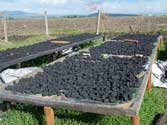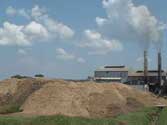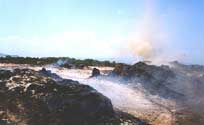CANECOAL, Western Kenya
Elsen Karstad, Nairobi, Kenya May 2003
 |
 |
| Canecoal on Drying Racks | Bagasse at Chemelil Sugar Factory |
Fellow stovers
Pass out the cigars- it's a Success! Chardust's new plant at the Chemelil Sugar Factory in Western Kenya has now been commissioned. We've begun commercial sales of 'CaneCoal' - charcoal briquettes made from carbonised bagasse.
Though it may be premature to call the project a full success just yet before we start turning a profit and prove replicability that such an investment can be repaid in good time (DFID has help fund this prototype) the market reaction is very good and the product is excellent. We may soon be able to state categorically that CaneCoal is preferred to regular charcoal in Western Kenya. Our retail prices are equal or lower than lump wood charcoal retailed at the roadside, so we're competitive on price.
I'm surprised at the quality of the briquette- specially the ash level considering it's made of fibres from the stem of tall 'grass'. CaneCoal lights easily, burns slightly longer than regular charcoal, is hard enough to be transportable (though significantly more fragile than regular charcoal), and has surprisingly low ash. The ash level, at 12.5% for pure carbonised bagasse, is low enough to allow us to add some clay to improve hardness and burn duration.
We employed a professional market research group to survey the domestic charcoal consumer, and the results were not surprising. The preferred characteristics of charcoal are density (weight of individual lumps), how fast it lights, how long it burns, it's compact size and how hard it is.
What is NOT liked about charcoal is smoke, sparks, smell, excessive heat in the kitchen, and the threat of carbon monoxide (schools teach about this).
As you can infer- the quality of Kenya's artisanally produced charcoal is variable, with poorly carbonised material producing the smell smoke sparks.
Pure carbon burns cleanly. We were told that a dull sheen- as opposed to shiny- is sought after as an indicator of good quality.
CaneCoal doesn't smell (other than a whiff of burnt sugar at ignition from the molasses added as one of the binders), does not spark at all, and produces no smoke. Density is almost exactly the same as good quality charcoal.... and of course it's got a dull sheen. Our briquette size is cylindrical averaging 7cm long by 3cm dia., was considered 'perfect' for the domestic charcoal Jiko. The size of lumps in wood charcoal varies tremendously larger pieces must be broken up by hand.
CANECOAL BURNING TRIALS IN KENYA CERAMIC JIKO
The last 10 CaneCoal burn trials using 1kg fuel in a Kenya Ceramic Jiko with 2 L. water in an open alu. pot average out to the following:
CaneCoal:
Time from lighting to boiling: 15.6 min.
Duration from lighting to end of simmering: 173 min. (range 167 to 215)
Water loss from lighting to end of simmering: 2462 grams
Residual ash: 16%
Hardness- % powder + dust + chips under 2cm dia. after dropping from 2m onto concrete: 28%
By way of comparison
Regular lump wood charcoal:
Time from lighting to boiling: 22.0 min.
Duration from lighting to end of simmering: 159 min. (range 75 to 220 min)Water loss from lighting to end of simmering: 2531 grams
Residual ash: 7.5%
Hardness- % powder + dust + chips under 2cm dia. after dropping from 2m onto concrete: 17%
So, in comparison to the market standard, we lose on hardness (will continue trying to improve on that), evaporate less water (slightly lower calorific value), and produce higher ash- a burn retardant. We are superior on ignition, smoke, spark, smell, size and burn duration. There's a slight negative on handling, as Canecoal has more surface dust than lump charcoal.
Overall, I reckon that leaves us on the plus side and allows us to compete head-to-head with traditional charcoal, though there's a lot of marketing work to be done. Introducing a new product to replace an old staple is always a challenge in Africa. We plan to include demonstrations (roadshows)at markets soon.
Our current rainy season has introduced a challenging production bottle-neck though, which is how to dry a sufficient quantity of bagasse from 50% to below 20% moisture level in the absence of much sun. We pump hot air salvaged from our carbonisers through the perforated floor of a 40 ft shipping container (fitted with extractor fans) to expedite drying, but this doesn't keep up with our 15t/day requirement of bulky dry bagasse. We may have to focus on double shifts during the dry seasons, which fortunately comprise about 9 months of the year.
I'll update as we progress from here.
Elsen L. Karstad
elk@wananchi.com
www.chardust.com
Nairobi Kenya
 |
| Canecoal Production Site |
Note: See related article from Village Power Newsletter #23 June 2002
 |
| Waste bagasse is normally dumped and burned in fields near the factory |
Women Air Jordan 1 Mid "Crimson Tint" 852542-801 Pink White Online, Price: $88.58 - Air Jordan Shoes
